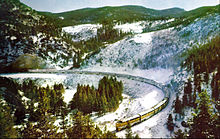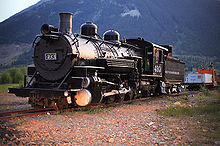Denver and Rio Grande Western Railroad

The Denver & Rio Grande Western Railroad , or D & RGW for short , was one of the oldest railroad companies in the western United States . End of the 19th century built the 1870 as a Denver & Rio Grande Railway established company narrow gauge railway lines with the track width of 3 feet through the Rocky Mountains , then an engineering feat. It soon became apparent that the narrow-gauge system was causing capacity bottlenecks and required expensive reloading, which is why the network was soon converted to the standard gauge . On August 9, 1988, the Anschutzgroup , which owned the Rio Grande, took over the Southern Pacific Railroad , causing the Rio Grande de jure to disappear from the scene. In fact , locomotives and cars in the D&RGW design are still in use today. Today the remains belong to the Union Pacific Railroad .
history
The Denver and Rio Grande Railroad (D&RG) was founded in 1870 by General William Jackson Palmer as a narrow-gauge railway with the long-term goal of connecting Denver in Colorado and Mexico City . The narrow gauge was chosen because of the lower construction costs and - just as importantly - because of the shorter construction time. The route should go over Raton Pass , which is in northern New Mexico . The feverish competition for route laying provoked a conflict with the Atchison, Topeka and Santa Fe Railway from 1877 to 1880 . Both rivals hired gunslingers and corrupted politicians. In June 1879 the Santa Fe defended their engine shed in Pueblo, Colorado with crooks hired from Dodge City under the leadership of Bat Masterson . The D&RG treasurer, RF Weitbrec, then paid the defenders to get them to leave. Ultimately, the Santa Fe won the right to the Raton Pass while the D&RG paid $ 1.4 million for the track rights through the Royal Gorge on the Arkansas River . Through the gorge, the train reached the mining area around Leadville . After that, the D&RG focused its activities on the development of the lucrative mining industry with tracks.
The Royal Gorge route
The D&RG built westward from Pueblo and reached Cañon City in 1874. The line was now built through the Royal Gorge and reached Salida, Colorado on May 20, 1880 . A year later, Leadville to the north was reached. From Salida, the D&RG built another stretch westward over the Marshall Pass (3,305 m), where the North American Continental Divide was crossed, and reached Gunnison, Colorado on August 6, 1881 . Behind Gunnison, the train reached the famous Black Canyon . The tracks left the increasingly difficult canyon at Cimmaron and crossed the Cerro Summit, finally reaching Montrose (Colorado) on September 8, 1882 . From Montrose, a line across Delta to Grand Junction and there a connection with the Rio Grande Western Railroad was opened in March 1883 , creating a continuous narrow-gauge line from Denver to Salt Lake City .
The line from Pueblo to Leadville was converted to a three-rail track in 1887, which meant that both narrow-gauge and standard-gauge trains could use the route. Furthermore, narrow-gauge branches were built to Crested Butte , Lake City , Ouray and Somerset .
The San Luis Valley Route
From Walsenburg (Colorado) , south of Pueblo, a route to the west was built. It reached Alamosa in 1878 via the La Veta Pass . From Alamosa a line was built southwards via Antonito , where it finally reached Santa Fe, New Mexico . Another route was driven westward from Alamosa to Creede . Another line with one of the longest straight line sections (52.82 miles) ran north from Alamosa to Salida on the Royal Gorge route. South of Alamosa, in Antonito, a branch to the west was built. Over the Cumbres Pass (3,052 m) along the state line between Colorado and New Mexico , this route reached Durango in August 1881 . From there a section was laid to the mining areas to the north. In July 1882 this line reached its terminus in Silverton . Furthermore, a connection was built from Durango to Farmington in southern New Mexico.
Today the Durango-Silverton line is a museum railway called the Durango and Silverton Narrow Gauge Railroad , while the line from Antonito to Durango is only partially operated: through the Cumbres and Toltec Scenic Railroad , which also runs with museum trains from Antonito to Chama .
The Tennessee Pass
Northwest of Leadville, the D&RG built a line over the Tennessee Pass (3,121 m) to reach the mining areas around Aspen, Colorado before another competitor, the Colorado Midland Railway , did. The line ran through Glenwood Canyon to Glenwood Springs and reached Aspen in October 1887. The D&RG then built a connection with the Colorado Midland and drove the route further west, where it finally met the route to Salt Lake City in Grand Junction . Originally the line was viewed as a side route between the Pueblo and Grand Junction. In 1890, however, the route was nailed to standard gauge, making the Royal Gorge route to the south a secondary route.
Denver and Rio Grande Western

The original Denver and Rio Grande Western Railway built a line from Ogden, Utah, via Soldier Summit, to Grand Junction, Colorado . In 1889 it was renamed the Rio Grande Western Railway as part of a financial plan to convert it to standard gauge and built numerous branch lines in Utah to reach lucrative coal fields. In 1901 the Denver and Rio Grande merged with the Rio Grande Western and took over this completely in 1908. The rail company, however, was weakened by speculation conducted for funding the Western Pacific Railroad . During the First World War , the United States Railroad Administration (USRA) temporarily took over the D&RG. After the bankruptcy of the Western Pacific Railway in 1918, the D&RG fell under bankruptcy administration. As part of the reorganization in 1920, the line was renamed Denver and Rio Grande Railroad (D & RGW or DRGW).
The Moffat route
In 1931, the D & RGW bought the Denver and Salt Lake Western Railroad , a subsidiary of the Denver and Salt Lake Railroad (D&SL), which had acquired the rights to build a 40-mile link between the two railways. After years of negotiation, the D&RGW received the access rights for the D&SL line from Denver to the new branch to be built. In 1932 construction began on the junction called Dotsero Cutoff west of Glenwood Springs to Bond on the Colorado River . The place where the line was to branch off from the Moffat line was called Orestod (Dotsero spoken backwards), while the other end of the line was called Dotsero. In 1934 the construction of the line was finished, which now a direct connection from Denver to Salt Lake City was possible. Despite this significant improvement, the D & RGW had to file for bankruptcy again in 1935. After the reorganization, the D & RGW merged on March 3, 1947 with the D&SL, giving them control of "Moffat Road" and a branch line to Craig (Colorado) .
"Fast Freights" and the California Zephyr, 1950–1983


Finally relieved of the financial troubles of the past, D&RGW was able to offer a direct line from Denver to Salt Lake City, eliminating the need for a detour via Pueblo and the Tennessee Pass route. One problem remained, however: for transcontinental rail traffic, the route of the Union Pacific Railroad , which ran along the north, was far less mountainous and as a result the trains there were several hours faster. The solution was the D & RGW's Fast Freight philosophy, which made short and closely spaced freight trains possible. This is also an explanation for why the D & RGW, despite its location in one of the most productive coal mining areas in the USA, shut down the steam locomotives as quickly as possible and replaced them with diesel locomotives. In 1956 all standard gauge steam locomotives were turned off and scrapped. The reason was that, in contrast to steam locomotives, diesel locomotives could be more easily coupled together to form units. This was necessary in order to achieve the optimum in horsepower to keep to the tight schedule.
The sense of the D & RGW for its varied geographical location found expression in what is probably the most famous passenger train in the USA, the California Zephyr . This passenger train was operated between Chicago and Denver by the Chicago, Burlington and Quincy Railroad (CB&Q) and between Salt Lake City and Oakland (California) (with ferry and bus connections to San Francisco ) by the Western Pacific Railroad . Since the California Zephyr was unable to compete with the Union Pacific, which had a less mountainous route and a 39-hour timetable, the focus was on a rather leisurely "rail cruise" - with extensive views of the Rocky Mountains. Although the California Zephyr ran at full capacity and made its biggest profit in the 1950s, the train was only profitable in late spring, summer, and fall in the 1960s. In 1970 the Western Pacific, which lost millions of dollars, got out. However, the D & RGW refused to join the parastatal Amtrak system and continued to operate its own section as the Rio Grande Zephyr until 1983.
Although the D & RGW had the most modern standard gauge system ever in order to be able to compete with the other large freight railways, it continued to operate parts of the narrow-gauge railways, which were still steam-powered. This included the famous line from Durango to Silverton . Although most of the remaining narrow-gauge railways were shut down in the 1960s and 70s, this line and one more remained, which are still maintained today by private tourist railways.
Merger with the Union Pacific
On September 11, 1996, the Anschutzgroup sold the railway, which had now merged with the Southern Pacific Railroad , to the Union Pacific, partly in response to the recently completed merger of Burlington Northern with Santa Fe . Since the merger, the typical features of the old railway have slowly but surely been disappearing. On November 9, 2006, number 5371 was the last DRGW locomotive in service with the Union Pacific. She is serving as a pushing locomotive in Helper, Utah .
In 2006 the Union Pacific unveiled the UP 1989, an EMD SD70 in DRGW colors.
Passenger trains
| Train numbers | Train name | route | Years of use |
|---|---|---|---|
| 1/2 | Royal Gorge | Denver-Grand Junction (via Royal Gorge) | -1967 |
| 5/6 | The Exposition Flyer | Chicago Oakland | 1939-1949 |
| 5/6 | California Zephyr of Amtrak | Chicago Oakland | 1983– |
| 7/8 | Prospector | Denver-Salt Lake City / Ogden | 1941-1942; 1945-1967 |
| 9/10 | Yampa Valley Mail | Denver-Craig | -1968 |
| 17/18 | California Zephyr | Chicago Oakland | 1949-1970 |
| 17/18 | Rio Grande Zephyr | Denver-Salt Lake City | 1970-1983 |
| 19/20 | Mountaineer | Denver-Montrose | 1929 (?) - 1953 |
| 115/116 | San Juan Express | Alamosa-Durango | ~ 1890–1951 |
| 315/316 | Shavano | Salida-Montrose (via Marshall Pass) | -1941 |
| 461/462 | Silverton | Durango-Silverton | |
| Ski train | Denver Winter Park |
Web links
- drgw.net
- The Rio Grande Modeling & Historical Society
- Colorado Railroad Museum ( August 4, 2008 memento on the Internet Archive )
- The Ghost Depot




